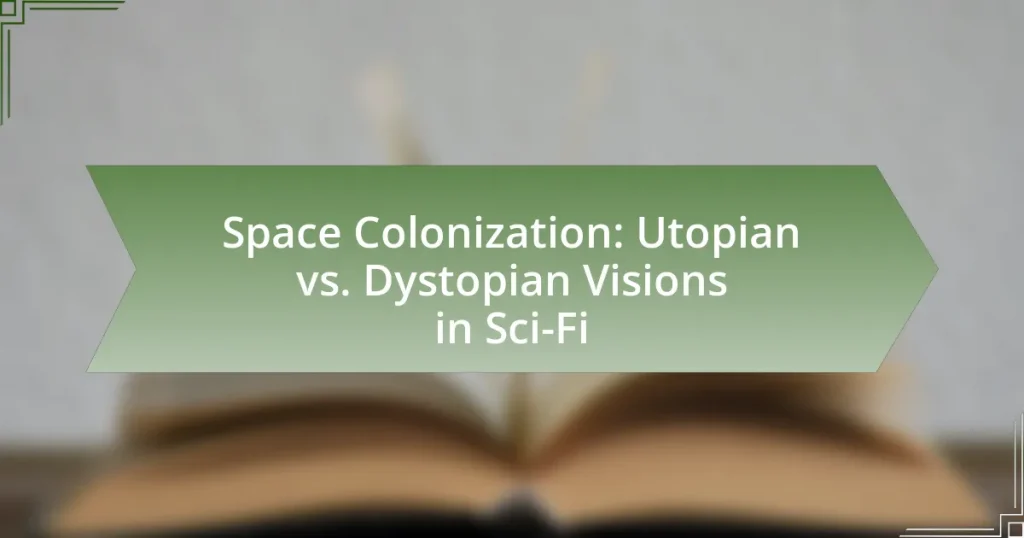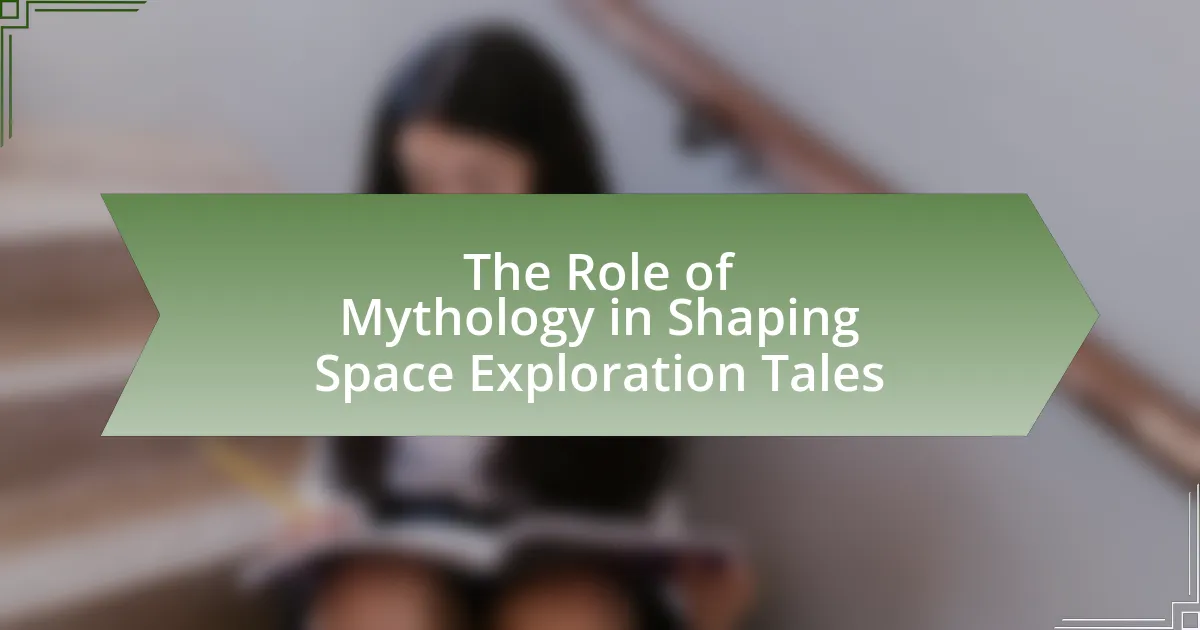Space colonization refers to the theoretical establishment of human settlements beyond Earth, particularly on celestial bodies like the Moon and Mars. The article explores the evolution of this concept, highlighting historical influences, cultural perceptions, and the primary motivations behind space colonization, such as survival and resource acquisition. It contrasts utopian visions of harmonious, sustainable societies with dystopian narratives that depict oppressive regimes and environmental degradation. Key challenges, including technological limitations and ethical dilemmas, are discussed alongside the psychological impacts of living in space colonies. The article emphasizes the lessons learned from science fiction narratives, advocating for a balanced approach that integrates ethical governance and sustainability in future space colonization efforts.

What is Space Colonization?
Space colonization is the theoretical concept of establishing human settlements beyond Earth, primarily on other celestial bodies such as the Moon or Mars. This idea has been explored in various scientific studies and literature, highlighting the potential for humanity to expand its presence in the universe. For instance, NASA’s Artemis program aims to return humans to the Moon and establish a sustainable presence there, serving as a stepping stone for future missions to Mars. Additionally, the Mars Society advocates for the colonization of Mars, emphasizing the need for technological advancements and international cooperation to make this vision a reality.
How has the concept of Space Colonization evolved over time?
The concept of space colonization has evolved from early speculative ideas to more scientifically grounded proposals. Initially, in the 19th and early 20th centuries, authors like Jules Verne and H.G. Wells imagined space travel as a fantastical adventure, focusing on the utopian potential of human expansion into the cosmos. By the mid-20th century, with advancements in rocketry and the onset of the Space Age, the idea shifted towards practical considerations, exemplified by NASA’s Apollo program, which aimed to land humans on the Moon.
In recent decades, the discourse has further matured, incorporating concerns about sustainability and ethical implications. The emergence of private space companies, such as SpaceX and Blue Origin, has introduced a commercial aspect to space colonization, emphasizing the feasibility of establishing human settlements on Mars and beyond. This shift reflects a growing recognition of both the opportunities and challenges associated with extraterrestrial habitation, including resource management and the potential for societal issues reminiscent of dystopian narratives in science fiction.
What historical events influenced the idea of Space Colonization?
The idea of space colonization has been influenced by several historical events, notably the Space Race during the Cold War, which spurred technological advancements and public interest in space exploration. The launch of Sputnik by the Soviet Union in 1957 marked the beginning of this competition, leading to significant milestones such as the Apollo 11 moon landing in 1969, which demonstrated human capability to explore extraterrestrial environments. Additionally, the environmental movements of the 1960s and 1970s, particularly the publication of “Silent Spring” by Rachel Carson in 1962, raised awareness about Earth’s ecological limits, prompting discussions about the necessity of finding alternative habitats beyond our planet. These events collectively shaped the vision of space colonization as a potential solution to humanity’s challenges on Earth.
How do cultural perceptions shape our understanding of Space Colonization?
Cultural perceptions significantly shape our understanding of space colonization by influencing the narratives and ideologies surrounding it. For instance, cultures that emphasize exploration and innovation often view space colonization as a natural progression of human advancement, reflecting a utopian vision where humanity thrives in new environments. In contrast, cultures that prioritize environmental stewardship and caution may perceive space colonization as a dystopian endeavor, fearing the replication of Earth’s ecological mistakes in new worlds. Historical examples, such as the American frontier narrative, illustrate how cultural contexts can frame space colonization as either a heroic quest or a reckless venture, impacting public opinion and policy decisions related to space exploration.
What are the primary motivations behind Space Colonization?
The primary motivations behind space colonization include the survival of humanity, resource acquisition, and scientific advancement. The survival of humanity is driven by the need to mitigate existential risks, such as climate change, nuclear war, or asteroid impacts, which could threaten life on Earth. For instance, Stephen Hawking emphasized the importance of becoming a multi-planetary species to ensure long-term survival. Resource acquisition involves seeking out materials and energy sources that are scarce on Earth, such as rare minerals found on asteroids or the potential for solar energy in space. Scientific advancement is motivated by the desire to explore and understand the universe, leading to technological innovations that can benefit life on Earth. Historical examples include the Apollo missions, which spurred advancements in technology and engineering.
Why do some view Space Colonization as a solution to Earth’s problems?
Some view space colonization as a solution to Earth’s problems because it offers the potential for resource expansion, environmental relief, and the survival of humanity. Proponents argue that establishing colonies on other planets could alleviate overpopulation and resource depletion on Earth, as evidenced by studies indicating that Earth’s resources are being consumed at an unsustainable rate. For instance, the Global Footprint Network reports that humanity is currently using the equivalent of 1.7 Earths to support its consumption. Additionally, space colonization could provide a backup for humanity in case of catastrophic events on Earth, such as climate change or nuclear war, thereby ensuring the long-term survival of the species.
What economic factors drive the interest in Space Colonization?
Economic factors driving interest in space colonization include the potential for resource extraction, technological advancements, and the expansion of markets. The prospect of mining asteroids for valuable materials, such as rare earth metals, presents a lucrative opportunity, as evidenced by the estimated $100 trillion worth of resources in the asteroid belt. Additionally, advancements in technology reduce costs and increase feasibility, with companies like SpaceX reducing launch costs significantly, making space more accessible. Furthermore, the expansion of markets into space, including tourism and habitation, creates new economic opportunities, as seen in the growing interest from private companies and governments in establishing a presence beyond Earth.
What are the key challenges associated with Space Colonization?
The key challenges associated with space colonization include technological limitations, resource management, human health risks, and ethical considerations. Technological limitations hinder the development of sustainable habitats and life support systems necessary for long-term human presence in space. Resource management is critical, as transporting materials from Earth is costly and inefficient; thus, utilizing in-situ resources on other celestial bodies is essential. Human health risks arise from exposure to radiation, microgravity effects, and psychological stress during long-duration missions, which can impact crew performance and well-being. Ethical considerations involve the potential for environmental harm to extraterrestrial ecosystems and the implications of colonizing other planets, raising questions about humanity’s responsibilities in space exploration.
How do technological limitations impact Space Colonization efforts?
Technological limitations significantly hinder space colonization efforts by restricting the development of necessary infrastructure and life-support systems. For instance, current propulsion technologies, such as chemical rockets, limit travel speed and duration, making missions to distant planets like Mars or beyond impractical within human lifetimes. Additionally, the lack of advanced life-support systems capable of recycling air, water, and nutrients efficiently poses challenges for sustaining human life in extraterrestrial environments. According to a report by NASA, the International Space Station relies on complex systems that are not yet scalable for long-term colonization. Furthermore, limitations in energy generation and storage technologies impede the ability to harness local resources, such as solar energy on Mars, which is crucial for sustaining colonies. These technological barriers create significant obstacles in achieving viable and sustainable human presence beyond Earth.
What ethical dilemmas arise from the pursuit of Space Colonization?
The pursuit of space colonization raises significant ethical dilemmas, primarily concerning the potential exploitation of extraterrestrial environments and the rights of any existing life forms. Ethical concerns include the moral implications of terraforming planets, which could disrupt or destroy native ecosystems, as highlighted by the Outer Space Treaty of 1967 that emphasizes the need for responsible stewardship of celestial bodies. Additionally, the colonization efforts may lead to socio-political issues, such as the potential for creating new forms of inequality and governance structures that mirror historical colonialism on Earth. These dilemmas necessitate careful consideration of the ethical frameworks guiding human expansion into space, ensuring that actions taken do not replicate past injustices or harm potential extraterrestrial life.

What are Utopian Visions of Space Colonization?
Utopian visions of space colonization envision a future where humanity thrives in harmony with nature and technology beyond Earth. These visions often include sustainable habitats, advanced technologies that enhance quality of life, and equitable societies that prioritize cooperation and peace. For instance, concepts like the O’Neill Cylinder propose self-sustaining habitats in space that utilize solar energy and recycle resources, reflecting ideals of ecological balance and community living. Such ideas are supported by theoretical frameworks in astrobiology and environmental science, which suggest that with proper planning, human settlements can exist sustainably in extraterrestrial environments.
How do Utopian narratives portray life in space colonies?
Utopian narratives portray life in space colonies as harmonious, technologically advanced societies where individuals coexist peacefully and benefit from equitable resource distribution. These narratives often depict environments that prioritize sustainability, advanced agricultural practices, and renewable energy sources, reflecting an idealized vision of human potential in overcoming challenges. For example, in works like “The Dispossessed” by Ursula K. Le Guin, the space colony Anarres exemplifies a society that values communal living and social equity, showcasing how cooperative governance can lead to a fulfilling existence. Such portrayals serve to inspire hope for a future where humanity can thrive beyond Earth, emphasizing the possibilities of innovation and collaboration in creating a better world.
What societal structures are envisioned in Utopian space colonies?
Utopian space colonies are envisioned to have egalitarian societal structures that prioritize communal living, shared resources, and democratic governance. These colonies often emphasize sustainability, technological integration, and social equity, aiming to eliminate poverty and inequality. For instance, concepts from various science fiction works, such as “The Dispossessed” by Ursula K. Le Guin, illustrate societies where resources are collectively managed, and decision-making is participatory, reflecting ideals of anarcho-syndicalism. Additionally, the design of these colonies often includes self-sufficient ecosystems, advanced recycling systems, and renewable energy sources, reinforcing the vision of a harmonious coexistence with the environment.
How do Utopian visions address environmental sustainability in space?
Utopian visions address environmental sustainability in space by proposing advanced technologies and societal structures that prioritize ecological balance and resource management. These visions often include concepts such as closed-loop life support systems, renewable energy sources, and sustainable agricultural practices that minimize waste and maximize efficiency. For instance, the design of space habitats in works like “The Dispossessed” by Ursula K. Le Guin illustrates a society that utilizes permaculture and recycling to maintain a self-sustaining environment. Additionally, the integration of biophilic design principles in space architecture aims to create environments that harmonize with natural ecosystems, reflecting a commitment to sustainability.
What role does technology play in Utopian visions of Space Colonization?
Technology is central to Utopian visions of Space Colonization, as it enables the creation of sustainable habitats, efficient resource management, and advanced transportation systems. These technological advancements are envisioned to facilitate human life on other planets, ensuring that colonization efforts lead to thriving, self-sufficient communities. For instance, innovations in renewable energy sources, such as solar power, are critical for providing energy in extraterrestrial environments, while advancements in life support systems are essential for maintaining human health and safety. Furthermore, the development of artificial intelligence and robotics is expected to enhance productivity and reduce human labor in harsh conditions, making colonization more feasible. Historical examples, such as the Apollo program, demonstrate how technology can successfully support ambitious space exploration goals, reinforcing the belief that similar technological progress will underpin future Utopian colonization efforts.
How is advanced technology depicted as a means to achieve Utopia in space?
Advanced technology is depicted as a means to achieve Utopia in space by enabling sustainable living environments, efficient resource management, and enhanced quality of life for inhabitants. In various science fiction narratives, such as Arthur C. Clarke’s “Rendezvous with Rama,” advanced technology facilitates the creation of self-sustaining habitats that mimic Earth’s ecosystems, allowing for a harmonious existence. Additionally, technologies like terraforming and artificial intelligence are portrayed as tools that can optimize agricultural production and energy consumption, thereby eliminating scarcity and conflict. These depictions are supported by theoretical frameworks in astrobiology and environmental science, which suggest that advanced technologies could realistically support human life in extraterrestrial settings, thus reinforcing the vision of a Utopian society in space.
What are the implications of artificial intelligence in Utopian space societies?
Artificial intelligence in Utopian space societies enhances efficiency, promotes equitable resource distribution, and fosters innovation. These societies leverage AI to optimize life support systems, manage habitats, and ensure sustainable practices, which are crucial for long-term survival in space. For instance, AI can analyze vast amounts of data to improve agricultural yields in controlled environments, ensuring food security. Additionally, AI-driven governance models can facilitate democratic decision-making processes, allowing for greater citizen participation and reducing the risk of authoritarianism. Research indicates that AI can also support mental health initiatives by providing personalized care and monitoring well-being, which is essential in isolated environments. Thus, the integration of AI in Utopian space societies not only improves quality of life but also addresses challenges unique to space colonization.
What are the psychological impacts of Utopian Space Colonization?
Utopian space colonization can lead to significant psychological impacts, including enhanced well-being, increased hope for the future, and a sense of community among colonizers. The prospect of creating a perfect society in space can foster optimism and motivation, as individuals envision a life free from Earth’s problems. Research indicates that environments perceived as utopian can improve mental health by reducing stress and anxiety, as seen in studies on community living and cooperative societies. Furthermore, the shared goal of building a new society can strengthen social bonds, leading to improved social cohesion and collective identity among colonizers.
How do Utopian visions influence human behavior and relationships in space?
Utopian visions significantly influence human behavior and relationships in space by fostering collaboration, innovation, and a sense of community among space colonizers. These ideals encourage individuals to work together towards common goals, such as sustainability and equality, which can lead to enhanced social bonds and cooperative problem-solving. For instance, the concept of a harmonious society in space, as depicted in works like “The Dispossessed” by Ursula K. Le Guin, illustrates how shared values can shape interpersonal dynamics and motivate collective action. Furthermore, studies on group behavior in isolated environments, such as the Mars Society’s analog missions, demonstrate that utopian frameworks can improve morale and reduce conflict, ultimately promoting a more cohesive and productive community in extraterrestrial settings.
What are the potential mental health benefits of living in a Utopian space colony?
Living in a Utopian space colony can provide significant mental health benefits, including reduced stress, enhanced social connections, and improved overall well-being. The structured environment of a Utopian colony, designed to prioritize mental health, can minimize daily stressors commonly found on Earth, such as economic instability and social inequality. Furthermore, the emphasis on community and collaboration in such a setting fosters strong social bonds, which are crucial for emotional support and resilience. Research indicates that social connections are linked to lower rates of anxiety and depression, highlighting the importance of a supportive community in promoting mental health. Additionally, the opportunity for individuals to engage in meaningful work and contribute to a collective vision can enhance a sense of purpose and fulfillment, further benefiting mental health.

What are Dystopian Visions of Space Colonization?
Dystopian visions of space colonization depict scenarios where human expansion into space leads to oppressive, authoritarian societies, environmental degradation, and social inequality. These narratives often illustrate a future where advanced technology exacerbates existing societal issues, resulting in a loss of individual freedoms and the exploitation of resources and populations. For instance, in films like “Elysium,” the wealthy inhabit a luxurious space habitat while the poor are left on a devastated Earth, highlighting stark class divides. Similarly, in literature such as “The Dispossessed” by Ursula K. Le Guin, the colonization process is fraught with ethical dilemmas and the consequences of imperialism. These examples underscore the potential for space colonization to mirror and amplify the flaws of contemporary society, serving as cautionary tales about unchecked technological and political power.
How do Dystopian narratives depict the consequences of Space Colonization?
Dystopian narratives depict the consequences of space colonization as leading to societal collapse, environmental degradation, and the exacerbation of inequality. These narratives often illustrate how the pursuit of new worlds results in the exploitation of resources, mirroring historical colonial practices on Earth, which can lead to conflict and oppression among colonizers and indigenous populations. For example, in works like “The Dispossessed” by Ursula K. Le Guin, the colonization of new planets reflects the struggles between capitalist and anarchist societies, highlighting the moral and ethical dilemmas faced by humanity. Additionally, films such as “Elysium” portray a stark divide between the wealthy elite living in luxury on a space station and the impoverished masses left on a deteriorating Earth, emphasizing the potential for space colonization to deepen existing social divides. These examples underscore the cautionary tales embedded in dystopian fiction, warning against the unchecked ambition of humanity in its quest for expansion beyond Earth.
What societal issues are highlighted in Dystopian space colonies?
Dystopian space colonies highlight societal issues such as class inequality, authoritarian governance, environmental degradation, and loss of individual freedoms. In these narratives, the stark division between the elite and the oppressed often reflects real-world socioeconomic disparities, where a privileged few control resources and power while the majority suffer. Authoritarian governance is frequently depicted through oppressive regimes that enforce strict control over inhabitants, limiting personal freedoms and dissent. Environmental degradation is illustrated by the harsh living conditions and exploitation of alien resources, mirroring concerns about sustainability on Earth. Additionally, the loss of individual freedoms is emphasized through surveillance and manipulation, showcasing the consequences of unchecked technological advancement and societal control. These themes serve as cautionary tales about the potential pitfalls of space colonization, urging reflection on current societal trajectories.
How do Dystopian visions reflect fears about technology and control?
Dystopian visions reflect fears about technology and control by illustrating scenarios where advanced technology leads to oppressive societal structures. These narratives often depict surveillance states, artificial intelligence dominance, and loss of individual autonomy, highlighting concerns that technological advancements can be manipulated to exert control over populations. For instance, George Orwell’s “1984” presents a totalitarian regime that employs technology for constant surveillance, embodying fears of privacy invasion and authoritarian governance. Similarly, in films like “The Matrix,” technology enslaves humanity, reinforcing anxieties about losing agency to machines. Such representations serve as cautionary tales, warning against unchecked technological progress and its potential to undermine freedom and human rights.
What are the environmental concerns raised in Dystopian visions of Space Colonization?
Dystopian visions of space colonization raise significant environmental concerns, primarily focusing on the potential for ecological destruction and resource depletion on other planets. These narratives often depict scenarios where human activities lead to the contamination of extraterrestrial environments, mirroring the ecological crises faced on Earth. For instance, the introduction of Earth-based organisms can disrupt native ecosystems, leading to biodiversity loss. Additionally, the extraction of resources from celestial bodies, such as mining asteroids or moons, poses risks of habitat destruction and pollution. These concerns are underscored by historical examples on Earth, where colonization efforts have frequently resulted in environmental degradation, such as deforestation and species extinction. Thus, dystopian portrayals serve as cautionary tales about the environmental ramifications of unchecked human expansion into space.
How do Dystopian narratives illustrate the exploitation of extraterrestrial resources?
Dystopian narratives illustrate the exploitation of extraterrestrial resources by depicting scenarios where powerful entities, often corporations or authoritarian governments, extract resources from other planets or celestial bodies without regard for ethical considerations or environmental consequences. For example, in the film “Avatar,” the human corporation seeks to mine unobtanium from Pandora, leading to the destruction of indigenous habitats and cultures. This reflects real-world concerns about resource extraction practices, such as mining on Earth, where local populations often suffer from environmental degradation and loss of livelihood. Such narratives serve as cautionary tales, highlighting the potential consequences of unchecked exploitation in the pursuit of profit and technological advancement.
What warnings do Dystopian stories provide about ecological collapse in space?
Dystopian stories warn that ecological collapse in space can lead to catastrophic consequences for humanity and the environment. These narratives often depict scenarios where overexploitation of resources, pollution, and neglect of sustainable practices result in barren landscapes and uninhabitable planets. For instance, in “The Martian” by Andy Weir, the struggle for survival on a desolate Mars highlights the fragility of ecosystems when human intervention is reckless. Additionally, “Interstellar” illustrates the dire consequences of agricultural collapse on Earth, prompting humanity to seek refuge in space, emphasizing the need for ecological stewardship. Such stories serve as cautionary tales, urging the importance of responsible resource management and the potential repercussions of ignoring ecological balance in the quest for space colonization.
What psychological effects are depicted in Dystopian Space Colonization scenarios?
Dystopian space colonization scenarios depict psychological effects such as isolation, anxiety, and existential despair. These effects arise from the extreme conditions of living in confined, hostile environments far from Earth, leading to a breakdown of social structures and increased mental health issues. For instance, studies on isolation in space missions, like the Mars Society’s simulations, reveal that prolonged confinement can exacerbate feelings of loneliness and depression, highlighting the psychological toll of such environments. Additionally, the fear of failure and the pressure to adapt to harsh realities contribute to heightened stress levels among colonizers, as illustrated in narratives like “The Martian” and “Interstellar,” where characters face overwhelming challenges that test their mental resilience.
How do Dystopian visions affect perceptions of identity and belonging in space?
Dystopian visions significantly influence perceptions of identity and belonging in space by portraying environments where societal structures are oppressive and individual autonomy is restricted. These narratives often depict characters grappling with their sense of self in hostile or controlled settings, leading to a fragmented identity that reflects the broader societal decay. For instance, in works like “The Dispossessed” by Ursula K. Le Guin, the protagonist’s struggle between two contrasting societies highlights how oppressive systems can alienate individuals from their cultural roots and sense of community. Such depictions underscore the psychological impact of living in a dystopian reality, where belonging becomes contingent upon conformity to authoritarian norms, thereby reshaping individual identities in the context of space colonization.
What are the potential mental health risks associated with living in a Dystopian space colony?
Living in a dystopian space colony poses significant mental health risks, including anxiety, depression, and social isolation. The harsh living conditions, lack of autonomy, and oppressive governance typical of dystopian settings can exacerbate feelings of hopelessness and despair. Research indicates that environments characterized by high stress and limited resources can lead to increased rates of mental health disorders; for instance, studies on isolated communities, such as those in extreme environments like Antarctica, show elevated levels of psychological distress. Furthermore, the absence of social support systems and the potential for conflict among inhabitants can further deteriorate mental well-being, as evidenced by psychological assessments conducted in confined spaces.
How can we reconcile Utopian and Dystopian visions of Space Colonization?
To reconcile Utopian and Dystopian visions of Space Colonization, it is essential to integrate the idealistic aspirations of creating a harmonious society with the realistic challenges and potential pitfalls of space exploration. This can be achieved by fostering a balanced approach that emphasizes ethical governance, sustainable practices, and inclusive participation in decision-making processes. For instance, historical examples such as the establishment of international treaties like the Outer Space Treaty of 1967 demonstrate the importance of collaborative frameworks in mitigating conflicts and ensuring equitable resource distribution in space. By learning from these precedents, stakeholders can address the fears associated with Dystopian outcomes while promoting the benefits of Utopian ideals, ultimately leading to a more comprehensive understanding of the implications of Space Colonization.
What lessons can we learn from Sci-Fi narratives about Space Colonization?
Sci-Fi narratives about space colonization teach us the importance of ethical considerations and the potential consequences of human actions. For instance, works like “The Martian” by Andy Weir highlight the necessity of problem-solving and cooperation in overcoming challenges, while “Avatar” by James Cameron warns against exploitation of resources and cultures. These narratives illustrate that successful colonization requires not only technological advancement but also a commitment to sustainability and respect for existing ecosystems. Additionally, dystopian themes in stories such as “The Expanse” emphasize the risks of social inequality and conflict, suggesting that equitable governance is crucial for harmonious coexistence in new environments.
How can these narratives inform real-world approaches to Space Colonization?
Narratives in science fiction, particularly those depicting utopian and dystopian visions, can significantly inform real-world approaches to space colonization by highlighting potential societal structures, ethical dilemmas, and technological challenges. For instance, utopian narratives often explore themes of cooperation, sustainability, and equitable resource distribution, which can guide policymakers in creating frameworks that prioritize social equity and environmental stewardship in space settlements. Conversely, dystopian narratives serve as cautionary tales, illustrating the consequences of neglecting ethical considerations, such as authoritarian governance or environmental degradation, thereby prompting stakeholders to proactively address these risks. Historical examples, such as the Apollo program’s emphasis on international collaboration and the lessons learned from the environmental impacts of Earth-based colonization efforts, further validate the importance of integrating insights from these narratives into the planning and execution of space colonization initiatives.
What best practices can be derived from Utopian and Dystopian perspectives?
Best practices derived from Utopian and Dystopian perspectives include fostering collaboration and ethical governance in space colonization. Utopian visions emphasize community, sustainability, and equitable resource distribution, which can guide policies that prioritize collective well-being and environmental stewardship. Conversely, Dystopian narratives highlight the risks of authoritarian control and environmental degradation, underscoring the necessity for transparency, accountability, and the protection of individual rights. Historical examples, such as the establishment of international space treaties, demonstrate the effectiveness of collaborative frameworks in mitigating conflict and promoting peaceful exploration. Thus, integrating these insights can lead to a balanced approach in developing space colonization strategies.




